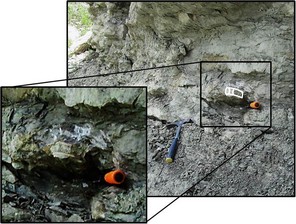@WFS,World Fossil Society,Riffin T Sajeev,Russel T Sajeev
Citation: Frederickson JA, Schaefer SN, Doucette-Frederickson JA (2015) A Gigantic Shark from the Lower Cretaceous Duck Creek Formation of Texas. PLoS ONE 10(6): e0127162. https://doi.org/10.1371/journal.pone.0127162
Abstract:Three large lamniform shark vertebrae are described from the Lower Cretaceous of Texas. We interpret these fossils as belonging to a single individual with a calculated total body length of 6.3 m. This large individual compares favorably to another shark specimen from the roughly contemporaneous Kiowa Shale of Kansas. Neither specimen was recovered with associated teeth, making confident identification of the species impossible. However, both formations share a similar shark fauna, with Leptostyrax macrorhiza being the largest of the common lamniform sharks. Regardless of its actual identification, this new specimen provides further evidence that large-bodied lamniform sharks had evolved prior to the Late Cretaceous.
@WFS,World Fossil Society,Riffin T Sajeev,Russel T Sajeev

Additional shark vertebrae found in situ in the same locality as OMNH 68860.
The surrounding lithology correlates with the indurated limestone bedforms 10.5 m above the base of the measured section (photo courtesy of L. Hall, 2013).

OMNH 68860 in (descending order) rostral, caudal, ventral, right lateral, dorsal, and left lateral views.
https://doi.org/10.1371/journal.pone.0127162.g004
![Reconstruction of the large lamniform sharks from the Duck Creek Formation and Kiowa Shale. KUVP 16343 and OMNH 68860 are both reconstructed as Leptostyrax macrorhiza and modeled after an odontaspidid. This reconstruction was based on dental similarities shared between Eoptolamnidae and Odontaspididae [14]. Both specimens represent the smallest calculated estimate based on the formula of Shimada [2]. Cretalamna appendiculata is reconstructed as a classic lamnid shark based on shared dental patterns between this genus and members of the family Lamnidae](http://www.worldfossilsociety.org/wp-content/uploads/2017/06/journal.pone_.0127162.g005.jpg)
Reconstruction of the large lamniform sharks from the Duck Creek Formation and Kiowa Shale.
KUVP 16343 and OMNH 68860 are both reconstructed as Leptostyrax macrorhiza and modeled after an odontaspidid. This reconstruction was based on dental similarities shared between Eoptolamnidae and Odontaspididae [14]. Both specimens represent the smallest calculated estimate based on the formula of Shimada [2]. Cretalamna appendiculata is reconstructed as a classic lamnid shark based on shared dental patterns between this genus and members of the family Lamnidae @WFS,World Fossil Society,Riffin T Sajeev,Russel T Sajeev



 June 24th, 2017
June 24th, 2017  Riffin
Riffin  Posted in
Posted in  Tags:
Tags: 